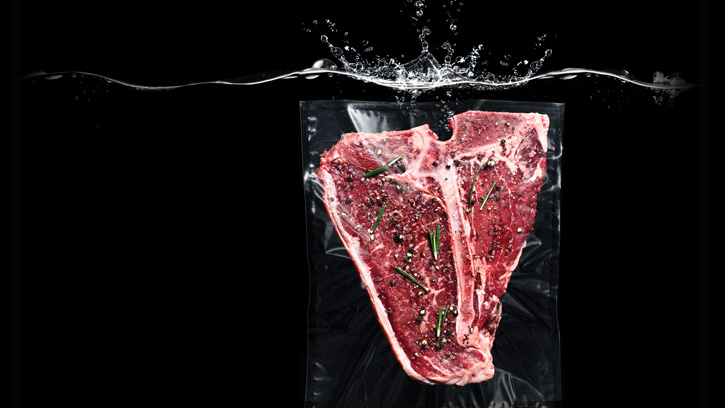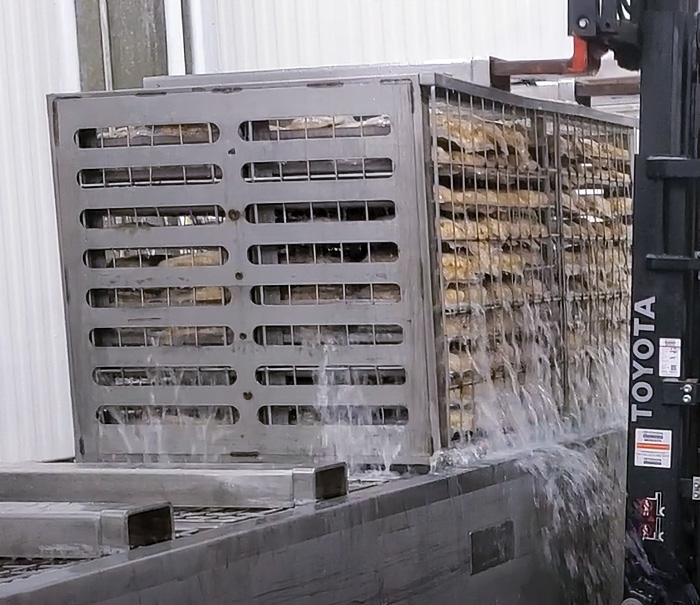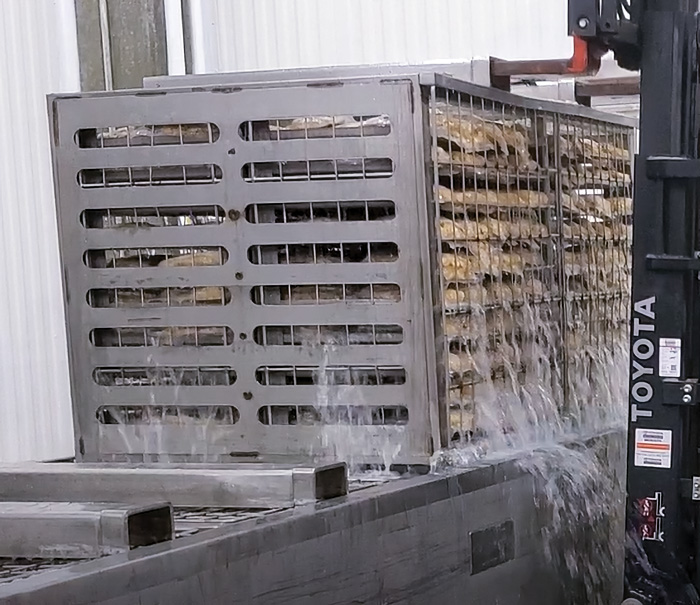Cooking Up Quality, Convenience Via Sous Vide
PROCESSING
Sous vide, a French term for “under vacuum,” is a cooking method in which foodstuffs are packaged in heat-stable vacuumized plastic pouches and then placed in water at controlled temperature and time combinations. This cooking method was initially used in the late 1960s to seal and pasteurize prepared foods, and then used by French chefs in the 1970s to increase fat retention to enhance the flavor of their dishes (Cooks Illustrated 2018).
Bruno Goussault has been applying sous vide technology to commercial food operations since the 1970s, when he implemented a sous vide dining program on the French railroad, and is considered the founder of modern sous vide. Since 1989, Goussault has been the chief scientist at Cuisine Solutions, a company that provides sous vide cooked products to foodservice and retail grocery customers.
Sous vide has been used in restaurants to produce food of consistent quality in a reasonable amount of time since 2010, which suggests that most people have eaten food prepared via sous vide whether they realize it or not. Between 2015 and 2021, sous vide has become more commonplace in the food industry; many companies have installed sous vide cooking lines to meet customer requests. Home kitchen sous vide circulators are available for $199 to $500, which has made sous vide cooking more affordable and available.
How Does It Work?
After food is vacuum packaged, the sous vide method uses precisely controlled heating in a circulating water bath to cook it. The temperature of the circulating water bath is maintained at or just above the desired final internal temperature of the product to prevent it from being overcooked, while making it safe for consumption. For example, a cut of meat that is 1 in thick can be pasteurized at temperature and time of 59 min and 66˚C, 257 min and 55˚C, and various combinations in between to make the product shelf stable (Baldwin 2012) with varying degrees of doneness.
“The first sous vide products were animal protein based, but years of research have made it possible to adjust time and temperature combinations and ingredient formulations to cook different products, including vegetables, seafood, pasta, eggs, plant proteins, and pretty much anything you can imagine,” says Sean Wheaton, vice president of culinary services at Cuisine Solutions. For example, lentils and rice can be cooked with sous vide, but differ in both the amount of water and ingredients to include as well as the required time and temperature combination.
Sous vide products are prepared using a cook-serve, cook-chill, or cook-freeze approach. Cook-serve is common in restaurants and at home; with this process, the food is consumed shortly after cooking. Food prepared using cook-chill and cook-freeze processes is produced on manufacturing lines at food companies and then reheated in a foodservice outlet so that it is ready as quickly as 5–10 min after it is ordered. For example, ribs can be cooked with a spice blend for 9–36 hr depending on the temperature (145˚F–165˚F) and then reheated in a water bath in a restaurant for 20–25 min. For a great 1.5 in thick filet mignon, sous vide cook it at 129˚F for 45 min to 2.5 hr and then sear it in a skillet to produce a medium rare steak.
It’s Efficient and Versatile
Vacuum sealing allows for efficient heat transfer from water and lengthens shelf life by preventing recontamination. Precision cooking allows reproducibility and prevents overcooking. It also allows tailoring sous vide to cook-serve, cook-chill, and cook-freeze all types of food products using optimum ingredient combinations, cook times, and cook temperatures.
“The combination of sous vide in conjunction with the appropriate functional ingredients allows the retention of moisture within the meat and gives you a juicy and tender bite that can be harder to achieve on a consistent basis with conventional cooking methods, especially when you’re limited to using clean label functional blends,” says Hector Portillo, product and concept development manager at Wayne Farms.
“Sous vide can be very versatile, having all of the ingredients in the bag so that it all cooks in its own components, retaining moisture and nutrients,” says Brian Davis, vice president of research and development at Simmons Prepared Foods. “Proteins that purge in the bag can now mix with seasoning blends to make a cook-in sauce, paving a way of endless flavor possibilities.”
Industry Applications
Sugar Creek, Ruprecht, and Cuisine Solutions all are large-scale sous vide processing specialists. Cuisine Solutions’ portfolio of sous vide–based foods includes more than 300 beef, pork, lamb, chicken, seafood, vegetable, pasta, and sauce products.
Wheaton describes the process used for a sear-and-sliced turkey breast: “The turkey breast is seared on the surface, sliced, vacuum packaged, and then cooked sous vide in the bag,” he says. The product can be opened at a grocery store or foodservice establishment and is ready to serve or heat.
Many food companies employ sous vide technology for a few products within a large portfolio. Portillo reports that Wayne Farms uses sous vide to create CHEF’S CRAFT Gourmet Chicken, a flame-grilled chicken breast that is sold at Walmart and foodservice establishments. “The product is pasteurized within the package to eliminate cross-contamination issues in commercial and residential kitchens while maintaining a gourmet quality product that can easily be rethermed in or out of the pouch,” Portillo says.
Chairmans Foods uses sous vide to produce meat and seasoned vegetable products such as meatloaf and green beans for foodservice. “The potential applications for sous vide are practically endless,” says Gina Hartline, production supervisor at Chairmans Foods. “Time and temperature combinations just need to be changed based on the product being made.”
Sous Vide Kitchen in New York City and Bamboo Asia in San Francisco are virtual kitchens that focus on food delivery and quick-service pick-up (Contreras 2020). Both use sous vide in food preparation, which allows them to efficiently service customers with minimal food waste.
Limitations and Safety Considerations
Sous vide requires special equipment to control the temperature of the water bath, a large container for the water, vacuum pouches, and a vacuum packager. These space and cost constraints can make it challenging to use sous vide in a restaurant.
Pathogens are the most serious concern when it comes to sous vide. “You must know what you are doing from a micro standpoint to correctly use sous vide, particularly from a retail consumer to home use standpoint,” Davis emphasizes. In addition, U.S. Food and Drug Administration–inspected kitchens need to have a HACCP plan to utilize this cooking method since cooking in low oxygen can lead to the growth of spore-forming bacteria.
The safest sous vide cooking method is cook-serve, also called cook-hold, in which the product is cooked sous vide and then held at or above 130˚F until served. The pathogens of concern are Salmonella species and pathogenic E. coli, so the food products must be cooked to control these pathogens. It is also critical to make sure that the product hold time is not long enough to decrease product quality. C. perfringens, C. botulinum, B. cereus, and L. monocytogenes are of concern in cook-chill and cook-freeze sous vide processes since the first three bacteria listed are spore formers, and L. monocytogenes is the most heat resistant non-spore-forming pathogen. L. monocytogenes must be controlled by the cooking process, and the product must be rapidly chilled and stored below 3.3˚C to yield 31 days of shelf life. If these guidelines are followed, the possibilities of sous vide processing are extensive.
A Promising Future
Sous vide cooking will increase in all markets in future years, especially in the areas of foodservice and home kitchen use. Cuisine Solutions, for example, recently used sous vide to produce egg bites for Starbucks. Expect such products to become more and more common in restaurant and quick-service settings. And as consumers get more familiar with the concept, they may be more open to adding sous vide capabilities in their home kitchens.
In addition, research initiatives like Cuisine Solutions’ work with sous vide and cryo concentration are expected to lead to new applications and product development opportunities—and even to help reduce food waste. “Food scraps such as carrot trimmings, corn peels, and other vegetable byproducts can be exposed to sous vide and cold cryo concentration to naturally extract flavors for use in food dishes that are cooked either sous vide or with other cookery methods,” says Wheaton.
REFERENCES
Baldwin, D. E. 2012. “Sous vide cooking: A review.” Int. J. Gastron. Food Sci. 1: 15–30.
Contreras, T. 2020. “Sous vide finds mainstream success in foodservice, consumer kitchens.” Smart Vide. https://www.sous-vide.cooking/vacuum-cook/process/.
Cook’s Illustrated. 2018. “The history of sous vide explained.” Aug. 28. https://www.cooksillustrated.com/articles/1142-the-history-of-sous-vide-explained.




